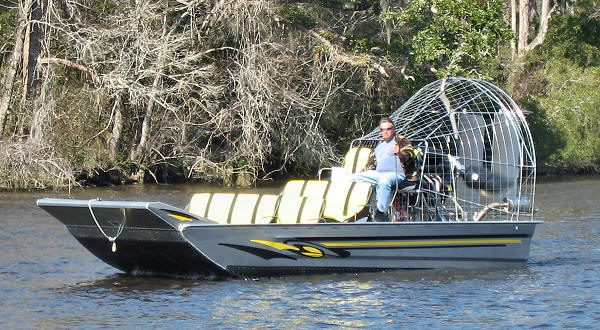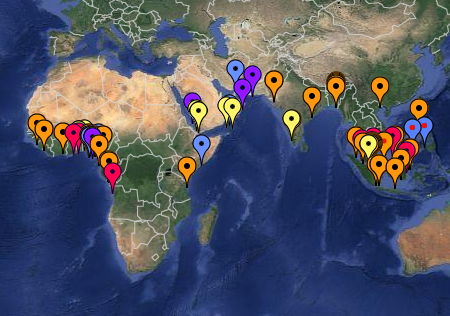airboat tour to see nature up close
Friday, 01 July 2011
by Steve Palisin
Some thoughts about Roger Moore debuting as 007 and eluding authorities while buzzing in a speedboat through the Louisiana bayou in “Live and Let Die” may come to mind when riding on Waccamaw Cooter Airboat Tours in Murrells Inlet.
However, the host, Plantation River Tours, and the riders, do the chasing from Wacca Wache Marina, all in search of wildlife along the Waccamaw’s backwaters.
“See how quiet it runs?” said Capt. Scott Cook, at the wheel, before suppertime last Friday, coasting until exiting the no-wake zone and heading north.
He then cranked up the airboat propeller, resembling the sound of a sports car revving up, and growing in volume, like that of a single or double-prop plane.
Wearing borrowed life jackets and complimentary ear plugs, the six passengers looked ahead, around and behind the boat. A rainbow held steady in the vapor from the exhaust of the propeller, which spun clockwise when seen from the boat, and Cook hugged the side of the river and followed a long, gradual curve.
An osprey nest atop a channel marker triggered the first stop. Two inhabitants almost identical in size looked up, yet felt unthreatened by the boat’s proximity from about 100 feet.
“Believe it or not, one’s a baby,” Cook said. “The mother’s on the left.”
Cook said the birds, also known as fish hawks and identified in flight by black marks in the crooks under their wings, have talons that include the equivalent of opposable thumbs, used for tearing up their catch for consumption.
After the boat resumed its whir heading down the middle of the river, a cormorant a quarter-mile ahead splashed out of the river, taking flight from the middle of the water.
Former rice fields
Shutting off the engine again later, Cook pointed out some prominent flora along “old abandoned rice fields” that remain part of land designated for wildlife preservation. Some pink flowers everyone noticed were swamp roses, he said.
“There’s wild rice out here,” he said, noting a sample along an embankment.
“It just comes back year after year, by itself. It’s like short-grain brown rice, and the actual rice in the wild grows at the top of the plant, like wheat.”
Cook counted about six native area plants within easy view, including pickeral weed, with purple flowers; cow lilies and primroses, both yellow; and hibiscus, white.
Sporting a baseball cap that never flew off his head, Jason Rosenberg asked about how plants in the water endure such skimming contact with the boat.
Cook said a part of vegetation he crossed in the morning looked untouched just several hours later.
“The water stands the rice all back up,” Cook said.
During the next stop, five miles from the marina, “as the crow flies,” as Cook said, he pointed out pine trees towering from Sandy Island.
Rosenberg, a passenger from Pawleys Island with son Zachary and his friend, Alson Thomas of Murrells Inlet – both 9 years old – confessed his disorientation in direction.
“I’m lost,” he said, “and I have no idea where we are, but we’re still close to civilization. It’s amazing.”
A lone waterfowl call snapped the silence – a wood duck, Cook said, noting only the hens make that loud a signal.
“I didn’t know that,” said Lisa Green of Surfside Beach, a registered nurse who works with Rosenberg, a neurologist at Waccamaw Community Hospital of Murrells Inlet. “That’s a smart duck.”
Crossing sawgrass
Seeing a swallow-tailed kite spurred another break downstream, before Cook cut down a creek on a stretch lasting several minutes. At times, the width of the waterway narrowed to 5 feet, and Cook zig-zagged through patches of sawgrass taller than the boat, as plants, including wild rice stems, tickled passengers’ elbows.
Taking a breather once back on the main channel, Cook explained some nuances about that path.
“When we went up,” he said, “we were driving over dirt.”
Throughout the trip, Alson reported his sightings, such as an alligator and several turtles sunbathing on a log.
As the airboat returned to the marina dock 55 minutes later, outdoor diners watched.
“We literally flew,” Green said.
Cook, who said he and Capt. Dale Prox began giving these rides in May, likes how no two excursions finish alike.
Having spent all of his 43 years in the area, Cook also shrimps for a living, and he has helped Plantation River Tours in leading the Springfield pontoon creek excursions nearby at Brookgreen Gardens.
Cook said the airboat’s speed reaches 50 mph, but averages 25 to 30 mph as the crew scouts for wildlife.
“We try to show them things they’ve never seen before,” he said.
Airboat piloting takes a different knack, though.
“When you think you have to slow down,” Cook said, “you have to speed up. In deeper water, it’s harder to drive. In an inch and a half of water … it does good.”
The airboat allows access to formerly unreachable sites, even by kayak, Cook said, especially when considering the rising noticeable alligator prevalence when the tidal estuaries ebb.
“It’s hard to believe you’re this close to Myrtle Beach and can still hide,” he said.
“It’s the best of both worlds, freshwater and saltwater.”
Finishing her third airboat tour, Green said each voyage has varied greatly, and she welcomes the extra knowledge to bring home.
“It’s almost always like a history lesson,” she said.
Rosenberg, who said he likes to zoom into the Atlantic jet stream to go fishing for an afternoon and return home in time for – and with – dinner, remarked on his first airboat ride.
“Running through the big grass” excited him the most, and he appreciated a new scope through which to observe wildlife.
“That’s just something you can’t do every day,” he said.



